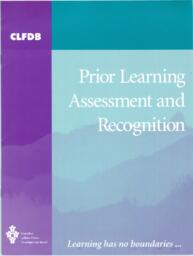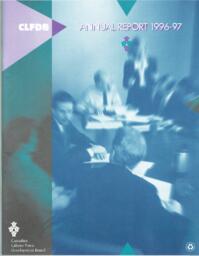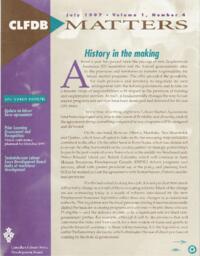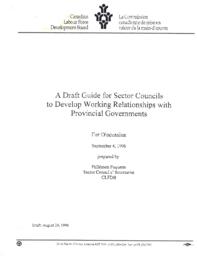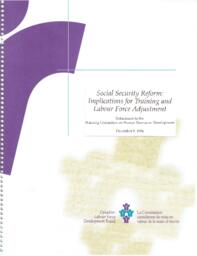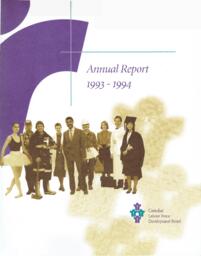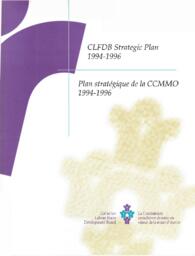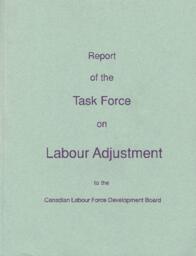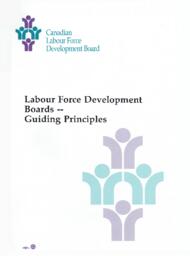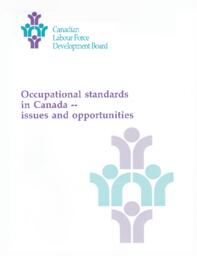Canadian Labour Force Development Board
Related Works
Content type
Digital Document
Description / Synopsis
This document is an informational brochure published by the Canadian Labour Force Development Board about Prior Learning Assessment and Recognition (PLAR). PLAR a process which can be used to look at what a person knows and can do. It may allow an individual to get some form of recognition for the skills and knowledge he or she has. PLAR should give equal value to learning and skills whether these skills come from school, community work, on-the-job training or other life experiences.
Origin Information
Content type
Digital Document
Description / Synopsis
This document is an Annual Report for 1996-1997 as published by the Canadian Labour Force Development Board. The report includes the names and roles of Board members, and sections on "Taking Stock of Major Change," "The Quest for Standards," "Financial Statements," and "Publications."
Origin Information
Content type
Digital Document
Description / Synopsis
This document is volume 1, number 4 of the publication CLFDB Matters, as published by the Canadian Labour Force Development Board. The issue contains the articles "History in the Making," "Saskatchewan Conference a Success," and "CLFDB Operations Plan 1997-98."
Origin Information
Content type
Digital Document
Description / Synopsis
This document provides a summary of the Labour Market Agreement signed between New Brunswick and Canada on December 13, 1996. This document was produced by the Canadian Labour Force Development Board.
Origin Information
Content type
Digital Document
Description / Synopsis
This document is a draft guide produced by the Canadian Labour Force Development Board concerning the transfer of responsibility for labour market training from the federal to provincial governments and how that affects Sector Councils. The document also contains contact information for the four existing provincial Labour Force Development Boards in New Brunswick, Nova Scotia, Saskatchewan, and British Columbia.
Origin Information
Content type
Digital Document
Description / Synopsis
This document is a report by the Canadian Labour Force Development Board to the Standing Committee on Human Resources Development regarding Social Security Reform. In March 1994, the CLFDB presented the Standing Committee on Human Resources Development with some concepts that define the essential ingredients of a truly effective, efficient and equitable training and labour force adjustment system. In November, the CLFDB gave the committee its views on proposals contained in the government's discussion paper on social security reform (the green paper). This paper elaborates on moving those suggestions from concept to practice. The ideas were developed from the significant work of the CLFDB over three years, including a special cross-country consultation with over 500 program participants, delivery agents and coordinators; deliberations of a CLFDB working group; and a recent forum involving over 180 representatives of all labour market partners and federal and provincial/territorial governments.
Origin Information
Content type
Digital Document
Description / Synopsis
This document is the 1993-1994 Annual Report by the Canadian Labour Force Development Board. It includes sections on the year in review, the year ahead, bios for members of the Board of Directors, Provincial Board information, Committees and Task Forces, Constituent Organizations, and Financial Statements.
Origin Information
Content type
Digital Document
Description / Synopsis
This document is the 1994-1996 Strategic Plan for the Canadian Labour Force Development Board. It was developed by Board Members and the Steering Committee. The resulting plan is composed of several sections which describe the CLFDB's vision of a model labour force development system; their mission; the planning environment in which they work; their mandate; their objectives for 1994-96 and their operating principles and values.
Origin Information
Content type
Digital Document
Description / Synopsis
This document is a report produced by the Task Force on Labour Adjustment, as established by the Canadian Labour Force Development Board. The members of the task force included John Keenan, David Robertson, Pramila Aggarwal, Keith Newman, Michael Lewis, and Kevin Coombs. The report focused on federal programming aimed at easing the adjustment of workers permanently displaced from employment, and on regulations in the Unemployment Insurance (UI) program that affect the use of the program for labour adjustment. The report contains a model of an effective labour adjustment process, and eighteen recommendations for improving the existing systems and processes.
Origin Information
Content type
Digital Document
Description / Synopsis
This document is a guide produced by the Canadian Labour Force Development Board and provides guiding principles for development and operation of labour force development boards across Canada, at the provincial/territorial and local level.
Origin Information
Content type
Digital Document
Description / Synopsis
This document is a report produced by the Canadian Labour Force Development Board. The document outlines the nature of occupational standards, their rationale, and the general framework for developing them; and identifies the objectives that may be served by the development of a comprehensive system of occupational standards in Canada. It also identifies some of the issues and options to be considered by all who have an interest in standards.
Origin Information
Content type
Digital Document
Description / Synopsis
This document is a study produced by Stevie Faragher about the Labour Force Development Strategy, a federal government policy paper introduced in early 1989. The purposes of this study are as follows: 1. To evaluate the effects of the federal government's Labour Force Development Strategy on the colleges and institutes in B. C. 2. To investigate the possibility of a co-ordinated framework which will assist the colleges and government to achieve their goals within the changed labour market guidelines. 3. To propose workable links between government, industry, and the colleges and institutes.
Origin Information

